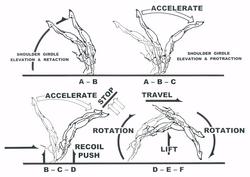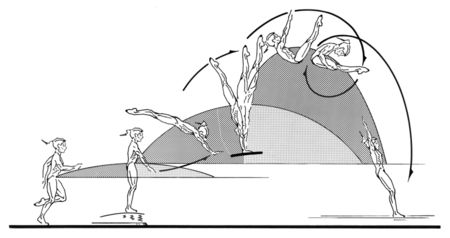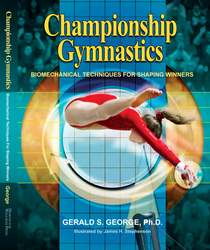|

___________________________________________________________
|
|
|
|
|
|
Gymnastics Technique: 
Factors Affecting Success
Part 3
by Gerald S. George, Ph.D.
December 31, 2012
|
A number of important training concepts directly influence:
- the rate of progress
- the quality of skill execution
- the resulting degree of success
- and the assurance of a reasonable margin of safety
that one can ultimately hope to achieve in gymnastics. Here are some of the more time-tested factors to consider. Part 3 of a 4-part series.
If you missed Part 1, CLICK HERE
If you missed Part 2, CLICK HERE
|
|
|
|
|
|
The term "learning" implies a relatively permanent change in a behavior or a movement pattern, whereas "performance" is an intermittent variable that fluctuates from time to time, depending on the given situation. In the training setting, coaches and gymnasts sometimes fail to understand and differentiate between these two concepts when evaluating readiness to ascend to the next level of difficulty.
Attempting to ascend the progressional ladder prematurely is perhaps the central limiting factor in realizing the performer's full potential. Simply performing the given element or sequence a number of times does not necessarily mean that true learning has taken place. For learning to have actually occurred, the performer must be able to demonstrate task mastery consistently over an extended period. The very word "routine" implies that which a gymnast performs is regular, usual, and habitual. When elements and sequences are truly learned, their execution becomes automatic, consistently accurate, and therefore predictable.
Every great gymnast calls on her automatic pilot.
Gymnastics movements, particularly at the basic levels, should not only be mastered but also learned to the point of unconscious habit. Such a training protocol is the barometer for proceeding to the next level of skill progressions. In addition, having a set of well-ingrained movement patterns allows the gymnast to employ her automatic pilot to execute the routine so she can actively concentrate on maximizing and accentuating the finer aspects of championship performance.
|
|
Skill Sequencing
| |
One often observes gymnasts spending inordinate amounts of time practicing individual skills or elements, hoping somehow to achieve absolute perfection before moving on. Although attaining a high level of skill mastery is essential, it should not be the ultimate focus of the training program. Rather, the bulk of training sessions should center on skill sequencing, i.e., practicing already-learned skills in sequence and then as full routines. This is true regardless of the level of the performer. After all, success in gymnastics demands mastery of routines, not simply "tricks"! Even at the most elementary stages, every attempt should be made to blend basic skills into basic skill sequences and finally into basic routines. This same protocol should be followed at the intermediate and advanced levels of training.
When skills are practiced in sequence rather than as individual elements, the gymnast enjoys the opportunity to develop intimate familiarity and improved technique with the unique transitional components inherent in the sequence. A better feel for the interrelationships among these already-learned skills is thereby realized, ensuring more fluid patterns in the performer's movement profile.
The practice of skill sequencing also serves as an excellent training protocol from the physiological perspective, as it develops (among other things) a performer's muscular endurance specific to the demands imposed by the given gymnastics routine. Who can deny that fatigue, the great "robber baron" of success, secretly lurks in every deconditioned athlete? There's an old Chinese proverb:
It's never too early to start winning.
|
|
Compensatory Skills--the Achilles Heel
|
Compensatory techniques are sequences, patterns, and shapes employed in place of correct technical execution. Look to any competition, any gymnast, any movement sequence, and one can observe scores of them. Although some degree of compensation is characteristic to all physical movement, the overzealous use of compensatory techniques tends to compound on itself, resulting in the performer ultimately "hitting a brick wall." In the rush to achieve ever greater degrees of skill difficulty, coaches and gymnasts are often lured into the mistaken belief that proper technique can somehow be traded off without consequence. In the final analysis, however, nothing could be further from the truth. Just ask any would-be champion!
Compensatory techniques enter your house a welcomed guest,
then your secret friend, and finally your master--in defeat, that is.
COMING SOON: Factors Affecting Gymnastics Success: Part 4
- Sureness of Execution
- Psychological Readiness--The Ultimate Domain
*This article excerpted from Championship Gymnastics: Biomechanical Techniques for Shaping Winners. For additional information, see Chapter 1, "Introduction to Gymnastics Technique."
|
"Championship Gymnastics" -- Featuring 140 Gymnastic Illustrations
Called "A True Masterpiece" by International Gymnast Magazine
Currently Used In 38 Countries Worldwide! |   140 Illustrations Show You the Exact Positions and Movements for Achieving Success and Shaping Championship Winners. 140 Illustrations Show You the Exact Positions and Movements for Achieving Success and Shaping Championship Winners.
Rather than laboring on complex physics formulas, fundamental principles of biomechanics are clearly explained and presented in layman's terms.
Easy to read and expertly illustrated, readers are guided effortlessly through a "conceptualization process" for developing ideal movement patterns. The book includes 140 technical illustrations by noted artist and gymnastics coach Jim Stephenson.
|
Get the Tools and Learn the Techniques You Need
to Become a Championship Winner!
- Learn Time-Tested Principles for Shaping Winners
- 140 Illustrations Show You the Exact Positions and Movements for Achieving Success and Shaping Championship Winners
- Understand the Biomechanical Principles Underlying All Gymnastics Skills
- Learn the Fundamental Concepts of Proper Training for Power and Flexibility
- Apply an Easy-to-Follow System for the Fundamental Patterns of Gymnastics Movement
- Discover Ten Key Teaching Concepts for Success in Each of the Four Olympic Gymnastics Events for Women
Take this opportunity to be among the first to receive the valuable information contained in this book, and start or continue your journey to achieve success in winning gymnastics championships!
|
|
|
|
|
|
|